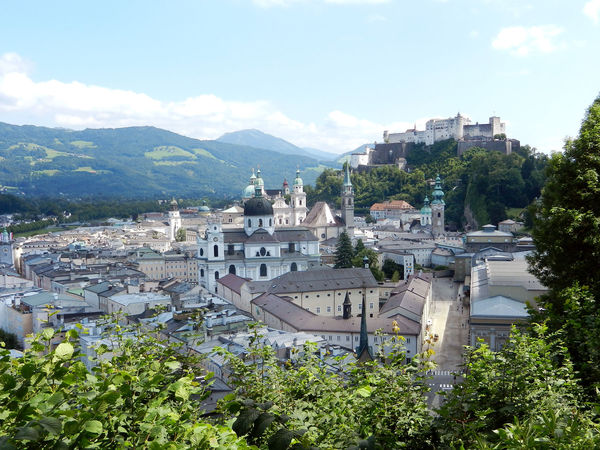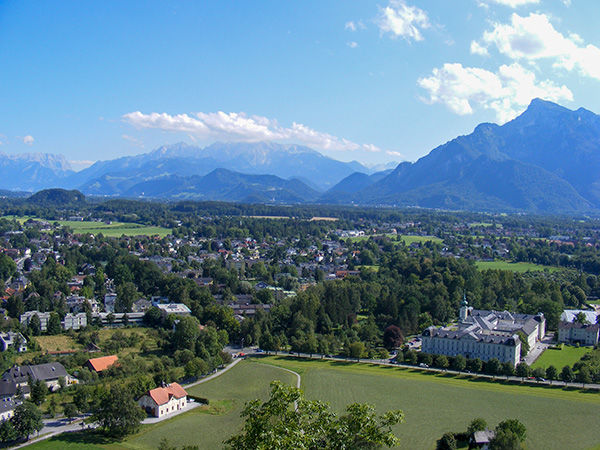Salzburg, Austria’s ‘Alpine Arcadia’
By Rick Steves

As the well-preserved hometown of one of history's most beloved composers, Salzburg has been on the tourist map since as long as there's been one. More recently, it's been a pilgrimage site for Sound of Music fans, as much of the film's most iconic scenes were filmed in and near the city. But charming Salzburg, with a tidy Old Town of Baroque domes and spires — all surrounded by alpine wonder — is fascinating in its own right, and it offers the most accessible taste of Austria you'll find anywhere.
Even without Mozart and the Von Trapps, Salzburg would draw visitors with its sheer beauty and quirky past. The city feels like a little world unto itself — perhaps partly because of its unique geography, with an Old Town that presses up against the river on one side, and the sheer cliffs of a mini-mountain on the other. But that feeling may also stem from the fact that Salzburg was an independent city-state until little more than 200 years ago.
The ruins of the one-time Roman town had been part of Bavaria, which lies just a few miles to the west and south (on maps, it looks as if Salzburg were a notch cut out of Bavaria). In about AD 700, Bavaria gave Salzburg to Bishop Rupert in return for his promise to Christianize the area. Rupert founded St. Peter's Abbey — a still-functioning Benedictine monastery, and gave Salzburg its name, which means "salt fortress." (As the city's patron saint, he's still celebrated every September at St. Rupert's Fair.)
Salzburg's rise was indeed funded by salt that was barged — and tolled — along the river from nearby mines that have been in operation since the Bronze Age. It's said that, at one point, one barrel of this "white gold" was worth the cost of one house.
But it was another three centuries before work began on what is now Salzburg's mighty Hohensalzburg Fortress, which towers 400 feet above the city. One of Europe's mightiest castles, this fortress was never really used. That was the idea: It was so foreboding, nobody attacked the town for a thousand years. The fortress was opened to the public in the 1860s, and now offers a handful of mediocre museums but impressive views — both over the spires of the Old Town, and, from its back, of the sublime alpine panorama just south of the city.
After Salzburg became fully independent from Bavaria in the late 1300s, the prosperous, well-protected city was ruled by a series of "prince-archbishops" (a cross between a king and a pope, but less powerful than either one). They built various fanciful palaces and elegant squares, but one prince-archbishop played a particularly large role in Salzburg's fate: Wolf Dietrich von Raitenau (r. 1587–1612), who aspired to turn Salzburg into a mini Rome north of the Alps. It was this vision that gave the city's architecture an Italian Baroque flair and created much of what tourists enjoy about the city today.
At its peak, Salzburg controlled an area about half the size of today's Austria. Napoleon finally put an end to Salzburg's independence in 1803 (they wisely handed him the keys to the fortress without putting up a fight). After the fall of Napoleon, Salzburg became part of Austria at last.
But as a 21st-century visitor you can still sense Salzburg's lingering grandeur — and experience it first-hand all around town. Tour the state rooms and museums of Wolf Dietrich's Residenz palace, marvel at the giant Baroque cathedral, or at the very least take in the harmonious pastel buildings that tower over the twisty lanes of the Old Town. You can even dine at what may well be Europe's oldest restaurant, the Stiftskeller St. Peter ("cellar of St. Peter's Abbey," still going after 1,200 years). Across the river, stroll the magnificent Mirabell Gardens, now famous for their role in The Sound of Music.
To delve deeper into Salzburg's history, visit the Salzburg Museum. Its centerpiece "Salzburg Myth" exhibit explores how the town's physical beauty attracted 19th-century Romantics who made it one of Europe's first tourist destinations, an "Alpine Arcadia." (It also challenges you to consider how people then — as today — filtered out certain harsh realities in favor of romanticized images of the places they visited.) Other sections cover earlier and later history, including the arrival of the music festival in the 1920s, which spurred Salzburg's status still more, drawing high-class visitors from across the globe. As the building was once the prince-archbishop's New Residence, many exhibits are in the lavish rooms where Salzburg's rulers entertained.
You can immerse yourself in Salzburg's Romantic-era mystique even more fully at the easy-to-enjoy Panorama Museum, which displays a wrap-around painting of the Salzburg as it appeared in the year 1829. In the early 19th century, before the advent of photography and tourism, 360-degree panorama paintings of great cities or events were popular, and this one spent 10 years touring the great cities of Europe. Today, the exquisitely restored painting offers a fascinatingly detailed look at a city that still looks much as it did then.
To enjoy classic Salzburg at play, spend an afternoon or evening at the Augustiner Bräustübl, a huge 1,000-seat, monk-run brewery that's been fueling Salzburgers since 1621. Nestled where the northeast tip of the Mönchsberg cliffs meet the river, its rustic and raw beer garden is reliably packed with all generations. On busy nights, it's like a Munich beer hall with no music but the volume turned up, as families and friends enjoy fish grilled on sticks, munch radishes artfully sliced into long delicate spirals, and hoist tall gray porcelain mugs of beer drawn from old-time wooden kegs. When it's cool outside, you'll enjoy a historic setting inside beer-sloshed and smoke-stained halls. On balmy evenings, it's like a Renoir painting — but with beer breath — where what seems like half of Salzburg gathers under a chestnut-tree orchard of conviviality.
With such a long history as a tourism magnet — around eight million sightseers prowl its cobbled lanes each year — Salzburg can feel pretty touristy. You don't go to Salzburg to avoid the tourists. You go to experience a town rich in history and physical beauty, which, in spite of the crowds, is thoroughly enjoyable.

